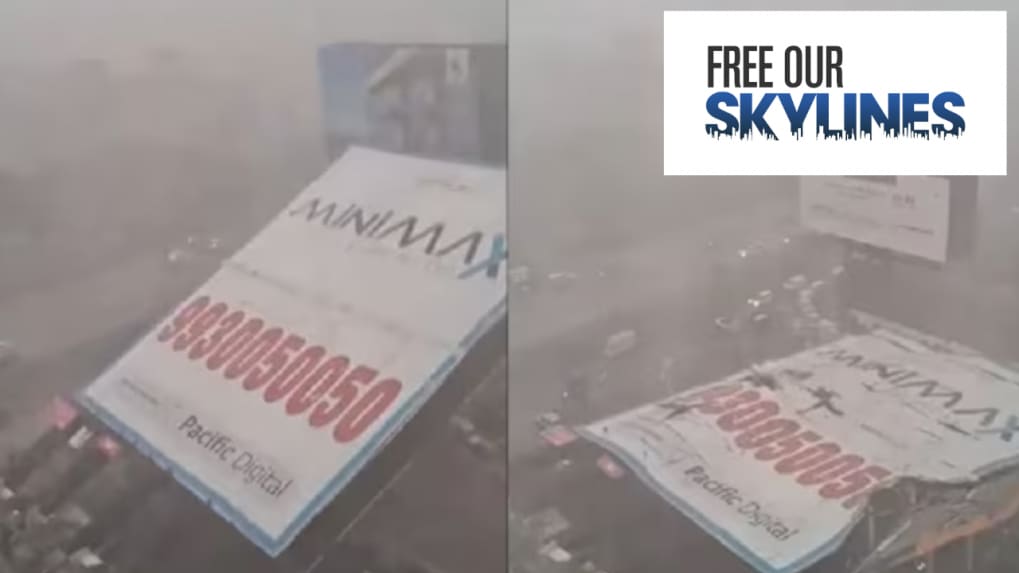Advertising
From Pink Slips to Silent Sidelining: Inside adland’s layoff and anxiety crisis

The Justice Dilip Bhosale Committee, constituted to probe the deadly Ghatkopar hoarding collapse, has recommended sweeping reforms in the regulation of outdoor advertising structures across Mumbai. The committee, which submitted its report to the Maharashtra government, has stressed that dangerous and unauthorized hoardings must be removed immediately, and licensed ones should face regular structural audits to ensure public safety.
The collapse of a massive illegal hoarding in Ghatkopar that killed 17 people and injured over 80 others was a man-made disaster, triggered by gross negligence, corruption, and brazen violation of civic safety norms. This is the damning conclusion of a high-level inquiry led by Justice (Retd.) Dilip Bhosale.
Accepting the Justice (Retired) Dilip Bhosale committee report on the Ghatkopar hoarding collapse case, the state cabinet has decided to implement a stricter policy for hoardings. The home department will write to all municipal corporations and local bodies to immediately conduct a survey of all hoarding sites in their jurisdiction and remove all illegal hoardings.
The report (accessed by Storyboard18), recommends the removal of all hoardings that obstruct pedestrian movement, especially those on footpaths. The panel has also called for strict enforcement of size restrictions, stating that no hoarding should exceed 40 feet by 40 feet. Rooftop and dead-wall hoardings, often seen across the city, should be banned outright, while private hoardings on visible properties should come under the same scrutiny as those on public land.
Every structure, the report insists, must carry clear permit details, undergo annual structural stability checks, and comply with local as well as national standards such as BIS, the Mumbai Municipal Corporation Act, and the National Building Code.
The committee has also flagged traffic safety as a critical concern. It has recommended that digital billboards with flashing lights, moving graphics, or video screens should not be installed near highways, junctions, or pedestrian-heavy zones, where they can distract drivers and cause accidents. Even where digital displays are permitted, the content should remain static for several seconds, and nighttime restrictions must apply. The report emphasizes that no hoarding should block road signs, signals, or sightlines, and structures that obstruct drivers or pedestrians should be removed without delay.
Another important suggestion is for coordination among agencies. The report highlights the need for approvals to be jointly vetted by the BMC, the Police, the Railways, and Traffic authorities, with a nodal body empowered to take immediate action against violations. Public awareness campaigns and stricter penalties for offenders, including advertisers and officials who enable violations, have also been recommended.
Justice Bhosale’s panel was formed on June 10, 2024, after the collapse of a mammoth hoarding in Ghatkopar on May 13, 2024, killed 17 people and injured more than 80 others. The structure, which measured 120 feet by 110 feet and stood 180 feet tall, crashed onto a petrol pump during strong winds. The inquiry has established that this was not a natural calamity but a preventable disaster caused by negligence, corruption, and disregard for safety regulations.
The committee has concluded that the Ghatkopar hoarding which collapsed was erected without a proper foundation, without structural stability certificates, and without any sanctioned design. The land on which it was built was wrongly cited as railway property, which helped the contractors bypass municipal oversight, although it was actually owned by the Maharashtra government through the Police Welfare Corporation. By exploiting this loophole, permissions were manipulated and BMC’s rules on hoarding size were flouted.
The report has also pointed out that the Railway Police Commissionerate allowed the erection of the billboard without verifying BMC’s jurisdiction or conducting technical checks, acting instead with the motive of raising revenue. It names senior officials including former Railway Police Commissioner Quaiser Khalid, who is described as “primarily responsible” for granting illegal permissions without tenders or approvals from the Director General of Police.
Another former Commissioner, Ravindra Shisve, has been criticized for inaction, as the committee felt that stricter supervision on his part could have led to the demolition of the structure before it collapsed. Retired BMC inspector Sunil Dalvi has also been linked to the matter, with the committee citing his financial dealings with contractors as evidence of collusion.
The final conclusion of the Bhosale Committee is clear: the Ghatkopar accident was not an act of fate but the outcome of systemic failures, regulatory loopholes, and deliberate misconduct by officials and private entities. By placing its recommendations at the core, the report seeks to transform Mumbai’s outdoor advertising landscape, ensuring that commercial interests do not override public safety.
From purpose-driven work and narrative-rich brand films to AI-enabled ideas and creator-led collaborations, the awards reflect the full spectrum of modern creativity.
Read MoreLooking ahead to the close of 2025 and into 2026, Sorrell sees technology platforms as the clear winners. He described them as “nation states in their own right”, with market capitalisations that exceed the GDPs of many countries.